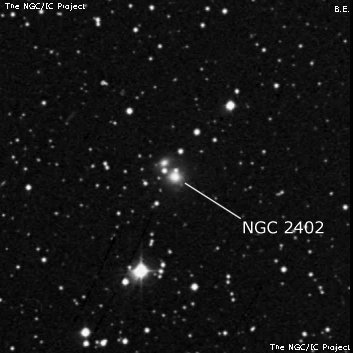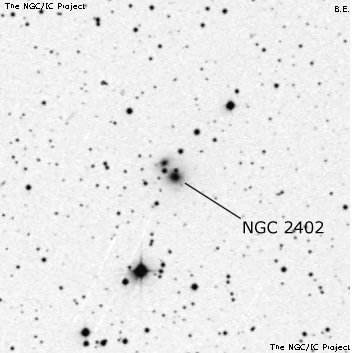NGC/IC Project Restoration Effort
(This is a very very beta version)
NGC2402


Basic Information
Location and Magnitude
Right Ascension: 7:30:46.5
Declination: +9:38:51
Constellation: CMI
Visual Magnitude: 13.9
Historic Information
Discoverer: Herschel W.
Year of discovery: 1784
Discovery aperture: 18.7
Observational
Summary description: eF, S, R, lbM, * inv
Sub-type: E?
Corwin's Notes
=====
NGC 2402. My old note read
Though both WH and JH have this as a single nebula with a single
star involved, there are actually two galaxies and two stars here. The
south-western galaxy is the brighter, but has the fainter star superposed,
while the fainter northeastern galaxy has the brighter star.
I suspect that the Herschels saw the entire group of four objects as a
nebulous blur with the brighter star occasionally glimmering through.
This isn't quite right. WH notes "2 vS and close sts with nebulosity left
doubtful". This reads like an observation of a nebulous double star. JH has
three observations, of which the second (in Sweep 123) is the most explicit:
"eF, R, lbM; = * 15 m; has the f of 4 stars near it." His first observation
from Sweep 120 could also be helpful: "eF; among several sts 13 .. 14 m; one
= 14 is in the neb." (His third observation from Sweep 132, simply reads
"Most excessively F.")
JH's four stars are actually a line running 2.7 arcminutes southeast from an
eleventh magnitude star. The fourth star is just 20 arcseconds northeast of
the nucleus of the brighter galaxy, and it is this galaxy that I now think
that both Herschels saw. My guess is that WH also saw the star that his son
noted explicitly, and thought it and the brighter galaxy's nucleus a double
star. My current position table entries reflect this.
Steve's Notes
=====
NGC 2402
24" (2/16/15 and 2/14/15): at 322x; faint to fairly faint, small, slightly elongated, ~25"x20", weak concentration with a very small brighter nucleus. A mag 13.5-14 star is at the east-northeast edge [21" from center]. This star is the last of four in a northwest to southeast string with two mag 13 stars and a mag 11 star at the northwest end. Also, a fainter mag 14.5 star is superimposed on the north edge - just 10" from center!
Forms a double system with PGC 200236 at the northeast edge [30" from center]. At 450x, it was seen as a very faint round knot (not 100%, but often visible with concentration), roughly 6" diameter.
17.5" (11/25/87): faint, very small, round. A mag 14 star is at the east edge 22" from center. A chain of four stars begin with a mag 14 star 40" N and forms a line to the NW. Located 3' N of mag 8.8 SAO 115540. This is a double system in contact, though the fainter companion (PGC 200236) at the NE edge was not noticed.



